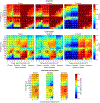Adaptive paradigms for mapping phonological regions in individual participants
- PMID: 30665008
- PMCID: PMC6424113
- DOI: 10.1016/j.neuroimage.2019.01.040
Adaptive paradigms for mapping phonological regions in individual participants
Abstract
Phonological encoding depends on left-lateralized regions in the supramarginal gyrus and the ventral precentral gyrus. Localization of these phonological regions in individual participants-including individuals with language impairments-is important in several research and clinical contexts. To localize these regions, we developed two paradigms that load on phonological encoding: a rhyme judgment task and a syllable counting task. Both paradigms relied on an adaptive staircase design to ensure that each individual performed each task at a similarly challenging level. The goal of this study was to assess the validity and reliability of the two paradigms, in terms of their ability to consistently produce left-lateralized activations of the supramarginal gyrus and ventral precentral gyrus in neurologically normal individuals with presumptively normal language localization. Sixteen participants were scanned with fMRI as they performed the rhyme judgment paradigm, the syllable counting paradigm, and an adaptive semantic paradigm that we have described previously. We found that the rhyme and syllable paradigms both yielded left-lateralized supramarginal and ventral precentral activations in the majority of participants. The rhyme paradigm produced more lateralized and more reliable activations, and so should be favored in future applications. In contrast, the semantic paradigm did not reveal supramarginal or precentral activations in most participants, suggesting that the recruitment of these regions is indeed driven by phonological encoding, not language processing in general. In sum, the adaptive rhyme judgment paradigm was effective in localizing left-lateralized phonological encoding regions in individual participants, and, in conjunction with the adaptive semantic paradigm, can be used to map individual language networks.
Copyright © 2019 Elsevier Inc. All rights reserved.
Figures






Similar articles
-
Language Mapping in Aphasia.J Speech Lang Hear Res. 2019 Nov 22;62(11):3937-3946. doi: 10.1044/2019_JSLHR-L-RSNP-19-0031. Epub 2019 Nov 22. J Speech Lang Hear Res. 2019. PMID: 31756153 Free PMC article. Review.
-
Adaptive Language Mapping Paradigms for Presurgical Language Mapping.AJNR Am J Neuroradiol. 2022 Oct;43(10):1453-1459. doi: 10.3174/ajnr.A7629. Epub 2022 Sep 22. AJNR Am J Neuroradiol. 2022. PMID: 36137653 Free PMC article.
-
Identification of the regions involved in phonological assembly using a novel paradigm.Brain Lang. 2015 Nov;150:45-53. doi: 10.1016/j.bandl.2015.07.013. Epub 2015 Aug 31. Brain Lang. 2015. PMID: 26335996 Free PMC article.
-
An adaptive semantic matching paradigm for reliable and valid language mapping in individuals with aphasia.Hum Brain Mapp. 2018 Aug;39(8):3285-3307. doi: 10.1002/hbm.24077. Epub 2018 Apr 17. Hum Brain Mapp. 2018. PMID: 29665223 Free PMC article.
-
A meta-analysis of fMRI studies on Chinese orthographic, phonological, and semantic processing.Neuroimage. 2012 Oct 15;63(1):381-91. doi: 10.1016/j.neuroimage.2012.06.047. Epub 2012 Jul 1. Neuroimage. 2012. PMID: 22759996 Review.
Cited by
-
Inattentive and hyperactive traits differentially associate with interindividual functional synchrony during video viewing in young children without ADHD.Cereb Cortex Commun. 2022 Feb 28;3(1):tgac011. doi: 10.1093/texcom/tgac011. eCollection 2022. Cereb Cortex Commun. 2022. PMID: 35291396 Free PMC article.
-
Language Mapping in Aphasia.J Speech Lang Hear Res. 2019 Nov 22;62(11):3937-3946. doi: 10.1044/2019_JSLHR-L-RSNP-19-0031. Epub 2019 Nov 22. J Speech Lang Hear Res. 2019. PMID: 31756153 Free PMC article. Review.
-
A systematic review of neuroimaging approaches to mapping language in individuals.J Neurolinguistics. 2023 Nov;68:101163. doi: 10.1016/j.jneuroling.2023.101163. Epub 2023 Aug 16. J Neurolinguistics. 2023. PMID: 37637379 Free PMC article.
-
Situating word deafness within aphasia recovery: A case report.Cortex. 2024 Apr;173:96-119. doi: 10.1016/j.cortex.2023.12.012. Epub 2024 Jan 26. Cortex. 2024. PMID: 38387377 Free PMC article.
-
The Precentral Gyrus Contributions to the Early Time-Course of Grapheme-to-Phoneme Conversion.Neurobiol Lang (Camb). 2022 Feb 10;3(1):18-45. doi: 10.1162/nol_a_00047. eCollection 2022. Neurobiol Lang (Camb). 2022. PMID: 37215328 Free PMC article.
References
-
- Ashburner J, & Friston KJ (2005). Unified segmentation. NeuroImage, 26, 839–851. - PubMed
-
- Baciu M, Kahane P, Minotti L, Charnallet A, David D, Le Bas JF, & Segebarth C (2001). Functional MRI assessment of the hemispheric predominance for language in epileptic patients using a simple rhyme detection task. Epileptic Disorders, 3, 117–124. - PubMed
-
- Baciu MV, Watson JM, Maccotta L, McDermott KB, Buckner RL, Gilliam FG, & Ojemann JG (2005). Evaluating functional MRI procedures for assessing hemispheric language dominance in neurosurgical patients. Neuroradiology, 47, 835–844. - PubMed
-
- Baldo JV, & Dronkers NF (2006). The role of inferior parietal and inferior frontal cortex in working memory. Neuropsychology, 20, 529–538. - PubMed
-
- Beckmann CF, & Smith SM (2004). Probabilistic independent component analysis for functional magnetic resonance imaging. IEEE Transactions on Medical Imaging, 23, 137–152. - PubMed
Publication types
MeSH terms
Grants and funding
LinkOut - more resources
Full Text Sources
Medical

